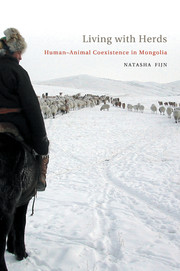Book contents
- Frontmatter
- Contents
- Lists of Plates, Figures, Maps, Tables, and Online Video Segments
- Glossary
- Acknowledgments
- LIVING WITH HERDS
- PART ONE CROSSING BOUNDARIES
- PART TWO THE SOCIAL HERD
- 3 SOCIAL SPHERES
- 4 NAMES, SYMBOLS, COLOURS, AND BREEDING
- 5 MULTISPECIES ENCULTURATION
- 6 TAMENESS AND CONTROL
- PART THREE LIVING WITH HERDS
- Appendix
- References
- Index
- Plate section
4 - NAMES, SYMBOLS, COLOURS, AND BREEDING
from PART TWO - THE SOCIAL HERD
Published online by Cambridge University Press: 03 May 2011
- Frontmatter
- Contents
- Lists of Plates, Figures, Maps, Tables, and Online Video Segments
- Glossary
- Acknowledgments
- LIVING WITH HERDS
- PART ONE CROSSING BOUNDARIES
- PART TWO THE SOCIAL HERD
- 3 SOCIAL SPHERES
- 4 NAMES, SYMBOLS, COLOURS, AND BREEDING
- 5 MULTISPECIES ENCULTURATION
- 6 TAMENESS AND CONTROL
- PART THREE LIVING WITH HERDS
- Appendix
- References
- Index
- Plate section
Summary
INTRODUCTION
Mongolian herders' description of herd animals is complex and encompasses a large number of terms based on an animal's physical appearance, behaviour, sex, age, and the characteristics of a particular individual. This chapter provides a description of the selection of specific animals for breeding and how the categorisation of animals is a key factor in the ability of human and other animals to coexist with one another. Mongolians class animals at the species level, which is “a combination of appearance and temperament, and derived from close study of their habits and mental and physical abilities” (Humphrey with Onon 1996: 98). Animals are also classified at the level of the herd but, within a herd, individuals may be marked to indicate the family to which they belong. Lastly, animals are identified at the level of the individual.
Herders assess the animals as having “good” or “bad” characteristics, just as humans have specific behavioural or physical characteristics. Some are given generic descriptive terms that can be used for any individual of that species with the same type of colour or pattern. Others are given unique names that describe the characteristics of the animal's personality with a name specific to that individual. This identification of particular individuals is extended to the selective breeding process. The herder ultimately chooses whether an animal is retained for producing young; castrated and utilised for riding or pulling carts; or culled because it is unlikely to survive or produce viable offspring.
- Type
- Chapter
- Information
- Living with HerdsHuman-Animal Coexistence in Mongolia, pp. 81 - 103Publisher: Cambridge University PressPrint publication year: 2011



